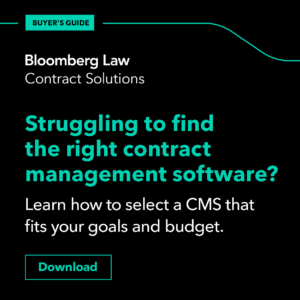
In some Contract Lifecycle Management platforms (CLMs), your dashboard can work to organize and present contract data in visually pleasing, useful formats that are easy to understand and share with others. Every time a user logs in, you see the contract data that is most relevant to your role. You can also drill down to analyze data at a more granular level and access rich details and essential knowledge that was difficult or impossible to find before the digital age. This valuable information informs actionable insights and allows you to engage in more meaningful conversations with executive teams across your organization.
Here are three ways to customize your CLM dashboard to operationalize your contract data and help your executives make profitable and effective decisions.
1) Monitor KPIs that support business goals.
CLM tools allow business teams to establish and monitor relevant contract KPIs over time. A good CLM helps you analyze a multitude of data points, including:
- Total number of contracts in the system.
- Total number of contract tasks.
- Number of pending contracts.
- Number of contracts expiring or renewing within the next 30 days.
- Contracts by department, contract type, and contract status.
How do you ensure you gain useful insights?
It’s easy to go overboard when tracking so many different data points. But you also don’t want to make assumptions or mold the data to support a predetermined outcome. Instead, try to hone in on the data that helps you and your executives make critical business decisions. Pay attention to the data and reports that provide clear guidance on key business activities. Ask: If we improve this metric, will it help lead to success? If so, then you know it’s an important point to track.
Relevant insights can include:
- Understanding how much time it takes to close specific types of deals.
- Spotting process bottlenecks that slow negotiation and signature progress.
- Determining what clauses are re-negotiated or rejected most often and replacing them with optimized language.
- Identifying which agreements contain non-standard terms and what those terms are to understand the diversity of your contract portfolio and better inform on risk.
- Comparing contract performance data from year to year to identify areas that need improvement.
Data analysis enables you to take action, then track data to determine the effects of the actions. You’ll know what actions helped your organization reach its goals and avoid repeating those that don’t. This is the kind of data-driven information that helps executive teams make profitable and effective decisions.
2) Enhance visibility into your complete contract portfolio.
The contract data helps tell a story to your executives. In some CLMs, your dashboard shows real-time snapshots of activities. Automated notifications keep stakeholders updated on all upcoming milestones, expirations, and renewals. With instant access to every contract’s status, users can see all active, pending, and expiring contracts at any time. Legal teams can more effectively monitor the tasks required to complete requests and finalize contracts. You can also analyze a range of related data points to understand the flow of business, including:
- Reporting the number of contracts assigned to each department and each person.
- Identifying which employees and departments generate which types of contracts.
- Learning which employees and departments send the most contract requests.
You may discover employees and departments that need more assistance. Or, you may spot stalled negotiations that need to be put back on track before your organization is put at risk. Your CLM dashboard allows you to continually monitor your contract portfolio, which gives you the visibility to spot areas of risk and issues that may cause trouble. You can easily focus on and understand what elements need to be addressed and by whom.
3) Quantify legal department performance and connect it to action.
Contract data can be valuable to departments outside of just the legal team. For example, your dashboard can also display the dollar amounts connected to your contracts, a value-add for finance and accounting teams. Tracking contract budget and spend information over time allows you to gain significant insight into the company’s financials.
In addition, you can see the total contract value by department or by contract type to see where business needs are most concentrated. Compare this year’s numbers to those of the previous year to see which business areas increase and decrease. Get the details you need to show where lawyers spend the majority of their time and effort. This can help you determine which groups might benefit from extra training or a better contract template.
As with monitoring KPIs, tracking contract data can reveal the effects of an action that was taken, which helps you connect value to specific actions. Bring valuable information to the table that allows decision-makers to plan for the best course of action going forward.
Your CLM dashboard helps you look forward to more success.
Your CLM dashboard includes visual representations of data with charts and graphs to make it even easier to understand and share what you learn. Every day, you, your legal team, managers, and executives access information-rich dashboards that help drive sound decisions. Your dashboard can help you understand contract performance so you can provide targeted legal advice based on data, which will help executives base decisions on a more thorough understanding of the past and a more predictable future. By customizing your dashboard, everyone can make more precise decisions with greater certainty about their expected effects to help the company continually build on its success.

















